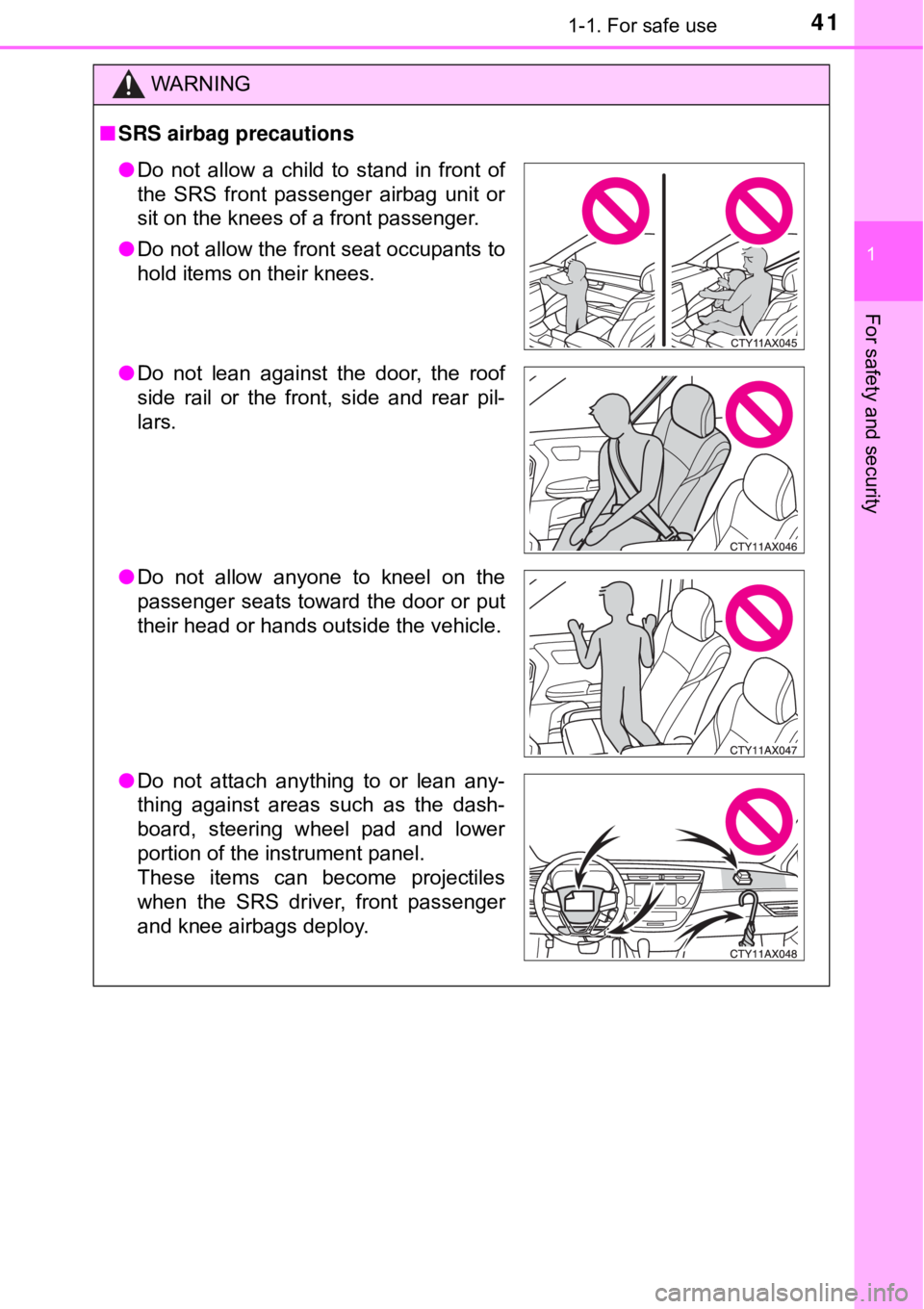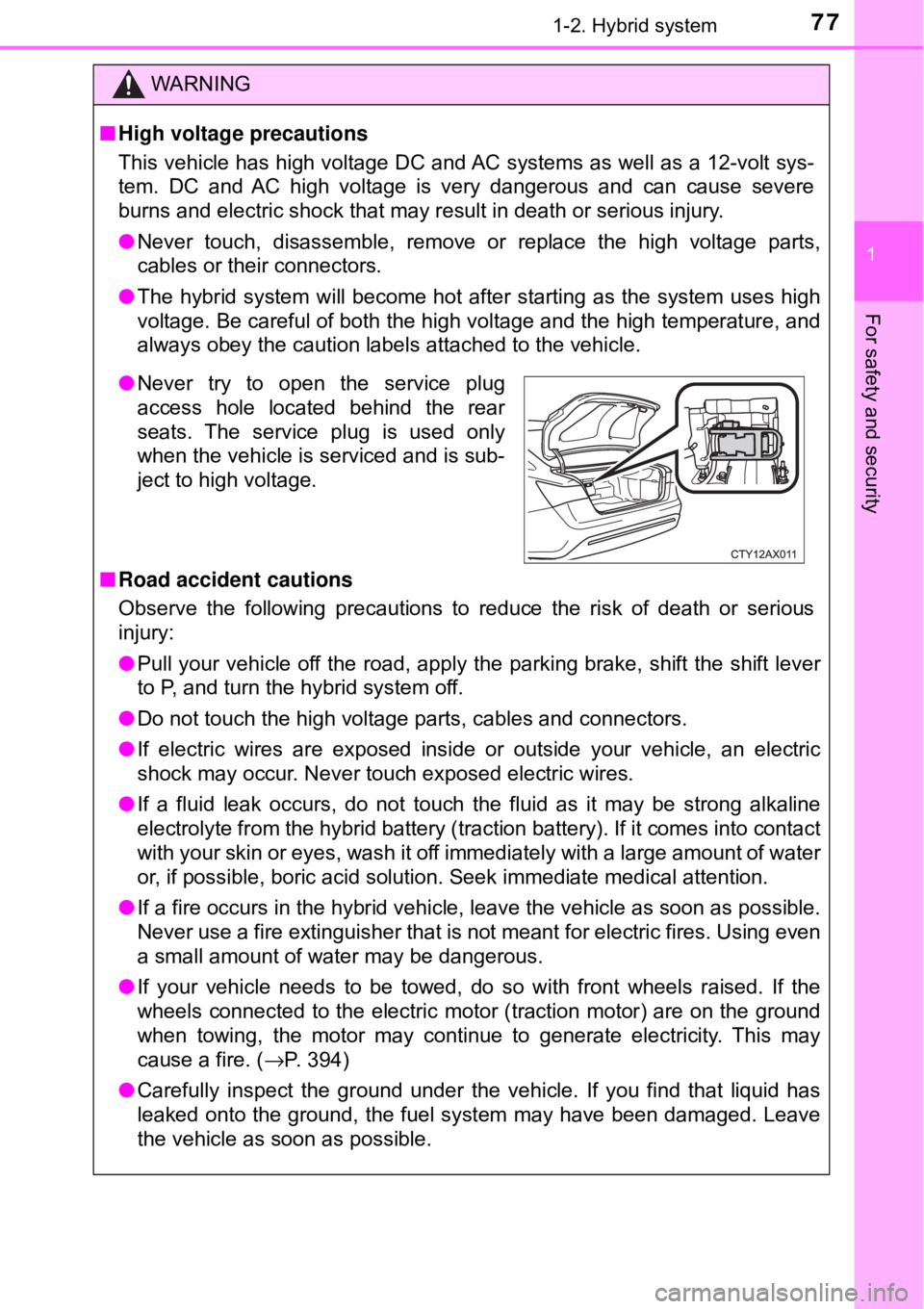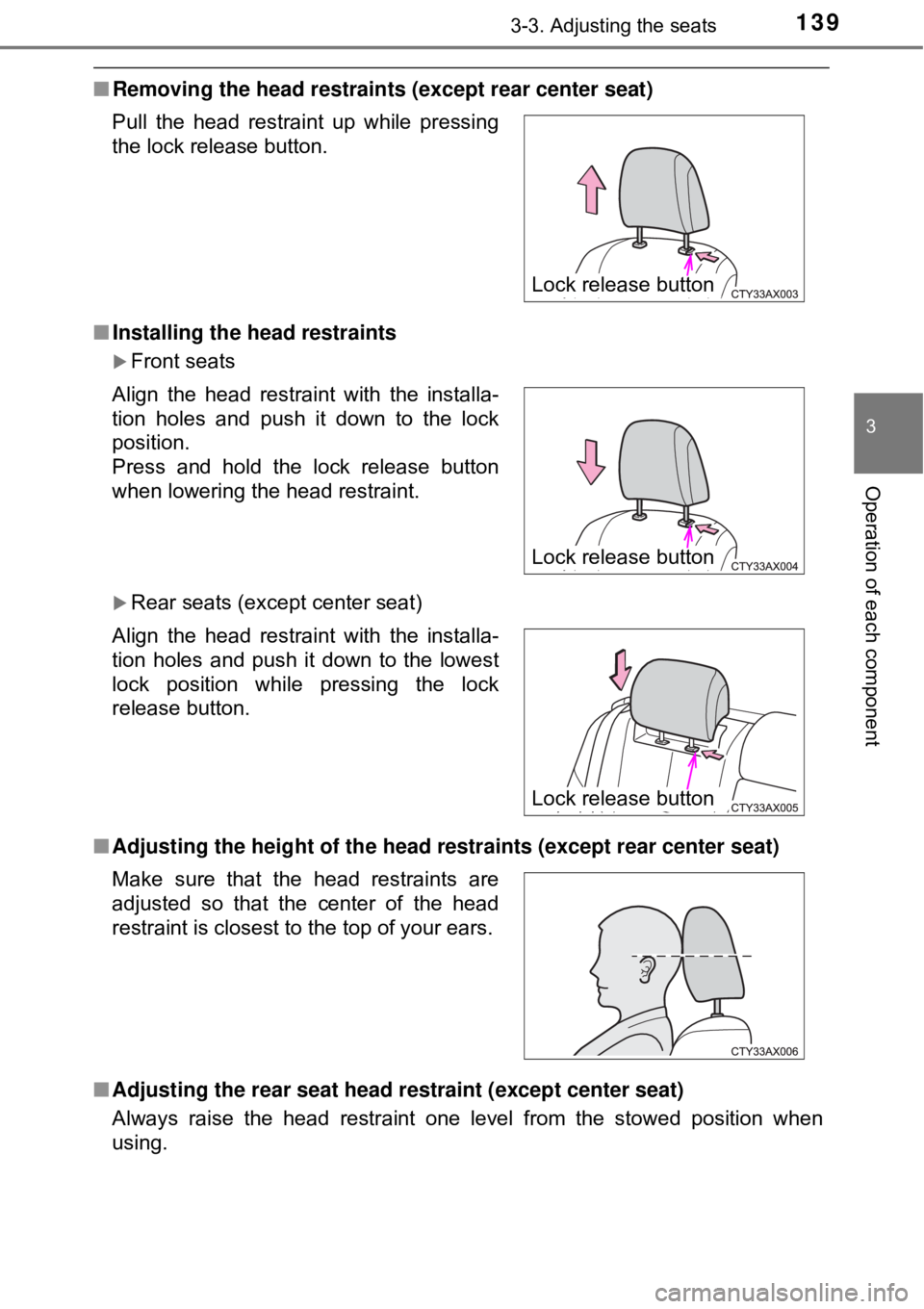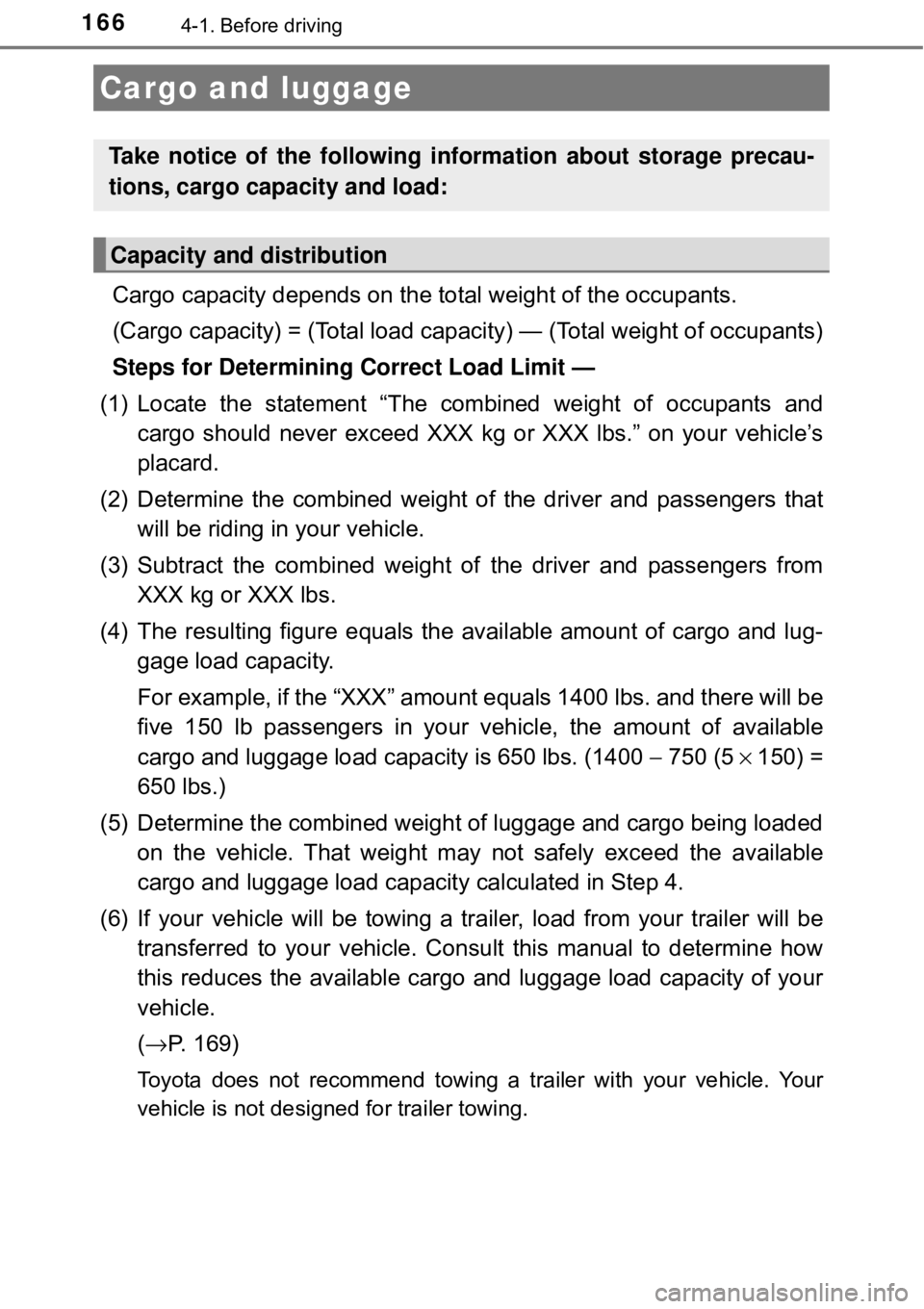tow TOYOTA AVALON HYBRID 2018 Owners Manual (in English)
[x] Cancel search | Manufacturer: TOYOTA, Model Year: 2018, Model line: AVALON HYBRID, Model: TOYOTA AVALON HYBRID 2018Pages: 492, PDF Size: 7.3 MB
Page 3 of 492

3
1
8 7
6
5
4
3
2
9
4-1. Before drivingDriving the vehicle ............. 156
Cargo and luggage............ 166
Vehicle load limits ............. 169
Trailer towing..................... 170
Dinghy towing.................... 171
4-2. Driving procedures Power (ignition) switch ...... 172
EV drive mode................... 178
Hybrid transmission........... 180
Turn signal lever................ 184
Parking brake .................... 185
4-3. Operating the lights and wipers
Headlight switch ................ 186
Automatic High Beam ....... 189
Windshield wipers and washer ............................ 193
4-4. Refueling Opening the fuel tank cap .......................... 198 4-5. Using the driving
support systems
Toyota Safety Sense P ...... 202
PCS (Pre-Collision System) ........................... 209
LDA (Lane Departure Alert with steering
control) ............................ 222
Dynamic radar cruise control.............................. 233
Cruise control .................... 246
BSM (Blind Spot Monitor)......... 250
• The Blind Spot Monitor function.......................... 252
• The Rear Cross Traffic Alert function detection
areas ............................. 257
Driving mode select switch .............................. 259
Driving assist systems ....... 261
4-6. Driving tips Hybrid vehicle driving tips ................................... 266
Winter driving tips .............. 269
4Driving
Page 5 of 492

5
1
8 7
6
5
4
3
2
9
6-1. Maintenance and careCleaning and protecting the vehicle exterior .......... 326
Cleaning and protecting the vehicle interior ........... 329
6-2. Maintenance Maintenance requirements ................... 332
General maintenance ........ 334
Emission inspection and maintenance (I/M)
programs ......................... 338
6-3. Do-it-yourself maintenance
Do-it-yourself service precautions ..................... 339
Hood.................................. 341
Positioning a floor jack ...... 342
Engine compartment ......... 343
12-volt battery ................... 352
Tires .................................. 356
Tire inflation pressure........ 365
Wheels .............................. 368
Air conditioning filter .......... 371
Electronic key battery ........ 373
Checking and replacing fuses ............................... 375
Light bulbs ......................... 378 7-1. Essential information
Emergency flashers ........... 392
If your vehicle has to be stopped in an
emergency....................... 393
7-2. Steps to take in an emergency
If your vehicle needs to be towed ...................... 394
If you think something is wrong ........................... 397
If a warning light turns on or a warning buzzer
sounds ............................. 398
If a warning message is displayed...................... 407
If you have a flat tire .......... 408
If the hybrid system will not start ........................... 420
If the electronic key does not operate properly ........ 422
If the 12-volt battery is discharged ................... 424
If your vehicle overheats......................... 429
If the vehicle becomes stuck ................................ 433
6Maintenance and care7When trouble arises
Page 39 of 492

391-1. For safe use
1
For safety and security
Your vehicle is equipped with ADVANCED AIRBAGS designed based
on the US motor vehicle safety standards (FMVSS208). The airbag
sensor assembly (ECU ) controls airbag deployment based on infor-
mation obtained from the sensors et c. shown in the system compo-
nents diagram above. This informat ion includes crash severity and
occupant information. As the airbags deploy, a chemical reaction in
the inflators quickly fills the airbag s with non-toxic gas to help restrain
the motion of the occupants.
WARNING
■ SRS airbag precautions
Observe the following precautions regarding the SRS airbags.
Failure to do so may cause death or serious injury.
● The driver and all passengers in the vehicle must wear their seat belts
properly.
The SRS airbags are supplemental devices to be used with the seat belts.
● The SRS driver airbag deploys with considerable force, and can cause
death or serious injury especially if the driver is very close to the airbag.
The National Highway Traffic Safety Administration (NHTSA) advises:
Since the risk zone for the driver’s airbag is the first 2 - 3 in. (50 - 75 mm)
of inflation, placing yourself 10 in. (250 mm) from your driver airbag pro-
vides you with a clear margin of safety. This distance is measured from
the center of the steering wheel to your breastbone. If you sit less than 10
in. (250 mm) away now, you can change your driving position in several
ways:
• Move your seat to the rear as far as you can while still reaching the ped- als comfortably.
• Slightly recline the back of the seat.
Although vehicle designs vary, many drivers can achieve the 10 in. (250
mm) distance, even with the driver seat all the way forward, simply by
reclining the back of the seat somewhat. If reclining the back of your
seat makes it hard to see the road, raise yourself by using a firm, non-
slippery cushion, or raise the seat if your vehicle has that feature.
• If your steering wheel is adjustable, tilt it downward. This points the air-
bag toward your chest instead of your head and neck.
The seat should be adjusted as recommended by NHTSA above, while
still maintaining control of the foot pedals, steering wheel, and your v\
iew
of the instrument panel controls.
Page 41 of 492

411-1. For safe use
1
For safety and security
WARNING
■SRS airbag precautions
● Do not allow a child to stand in front of
the SRS front passenger airbag unit or
sit on the knees of a front passenger.
● Do not allow the front seat occupants to
hold items on their knees.
● Do not lean against the door, the roof
side rail or the front, side and rear pil-
lars.
● Do not allow anyone to kneel on the
passenger seats toward the door or put
their head or hands outside the vehicle.
● Do not attach anything to or lean any-
thing against areas such as the dash-
board, steering wheel pad and lower
portion of the instrument panel.
These items can become projectiles
when the SRS driver, front passenger
and knee airbags deploy.
Page 77 of 492

771-2. Hybrid system
1
For safety and security
WARNING
■High voltage precautions
This vehicle has high voltage DC and AC systems as well as a 12-volt sys-
tem. DC and AC high voltage is very dangerous and can cause severe
burns and electric shock that may result in death or serious injury.
● Never touch, disassemble, remove or replace the high voltage parts,
cables or their connectors.
● The hybrid system will become hot after starting as the system uses high
voltage. Be careful of both the high voltage and the high temperature, and
always obey the caution labels attached to the vehicle.
■ Road accident cautions
Observe the following precautions to reduce the risk of death or serious
injury:
● Pull your vehicle off the road, apply the parking brake, shift the shift lever
to P, and turn the hybrid system off.
● Do not touch the high voltage parts, cables and connectors.
● If electric wires are exposed inside or outside your vehicle, an electric
shock may occur. Never touch exposed electric wires.
● If a fluid leak occurs, do not touch the fluid as it may be strong alkaline
electrolyte from the hybrid battery (traction battery). If it comes into contact
with your skin or eyes, wash it off immediately with a large amount of water
or, if possible, boric acid solution. Seek immediate medical attention.
● If a fire occurs in the hybrid vehicle, leave the vehicle as soon as possible.
Never use a fire extinguisher that is not meant for electric fires. Using even
a small amount of water may be dangerous.
● If your vehicle needs to be towed, do so with front wheels raised. If the
wheels connected to the electric motor (traction motor) are on the ground
when towing, the motor may continue to generate electricity. This may
cause a fire. ( →P. 394)
● Carefully inspect the ground under the vehicle. If you find that liquid has
leaked onto the ground, the fuel system may have been damaged. Leave
the vehicle as soon as possible.
●Never try to open the service plug
access hole located behind the rear
seats. The service plug is used only
when the vehicle is serviced and is sub-
ject to high voltage.
Page 126 of 492

1263-2. Opening, closing and locking the doors and trunk
■Conditions affecting operation
The smart key system uses weak radio waves. In the following situations, the
communication between the electronic key and the vehicle may be affected,
preventing the smart key system, wireless remote control and immobilizer
system from operating properly. (Ways of coping: →P. 422)
● When the electronic key battery is depleted
● Near a TV tower, electric power plant, gas station, radio station, large dis-
play, airport or other facility that generates strong radio waves or electrical
noise
● When carrying a portable radio, cellular phone, cordless phone or other
wireless communication device
● When the electronic key is in contact with, or is covered by the following
metallic objects
• Cards to which aluminum foil is attached
• Cigarette boxes that have aluminum foil inside
• Metallic wallets or bags
• Coins
• Hand warmers made of metal
• Media such as CDs and DVDs
● When other wireless keys (that emit radio waves) are being used nearby
● When carrying the electronic key together with the following devices that
emit radio waves
• Another vehicle’s electronic key or a wireless key that emits radio waves
• Personal computers or personal digital assistants (PDAs)
• Digital audio players
• Portable game systems
● If window tint with a metallic content or metallic objects are attached to the
rear window
Page 139 of 492

1393-3. Adjusting the seats
3
Operation of each component
■Removing the head restrain ts (except rear center seat)
■ Installing the head restraints
Front seats
Rear seats (except center seat)
■ Adjusting the height of the head restraints (except rear center seat)
■ Adjusting the rear seat head restraint (except center seat)
Always raise the head restraint one level from the stowed position when
using. Pull the head restraint up while pressing
the lock release button.
Align the head restraint with the installa-
tion holes and push it down to the lock
position.
Press and hold the lock release button
when lowering the head restraint.
Align the head restraint with the installa-
tion holes and push it down to the lowest
lock position while pressing the lock
release button.
Make sure that the head restraints are
adjusted so that the center of the head
restraint is closest to the top of your ears.
Lock release button
Lock release button
Lock release button
Page 155 of 492

155
Driving4
4-1. Before drivingDriving the vehicle ............. 156
Cargo and luggage ........... 166
Vehicle load limits ............. 169
Trailer towing..................... 170
Dinghy towing ................... 171
4-2. Driving procedures Power (ignition) switch ...... 172
EV drive mode .................. 178
Hybrid transmission........... 180
Turn signal lever................ 184
Parking brake .................... 185
4-3. Operating the lights and wipers
Headlight switch ................ 186
Automatic High Beam ....... 189
Windshield wipers and washer ............................ 193
4-4. Refueling Opening the fuel tank cap .................................. 198 4-5. Using the driving
support systems
Toyota Safety Sense P ..... 202
PCS (Pre-Collision System)........................... 209
LDA (Lane Departure Alert with steering
control) ............................ 222
Dynamic radar cruise control ............................. 233
Cruise control .................... 246
BSM (Blind Spot Monitor) ........ 250
• The Blind Spot Monitor
function ......................... 252
• The Rear Cross Traffic Alert function detection
areas ............................. 257
Driving mode select switch .............................. 259
Driving assist systems ...... 261
4-6. Driving tips Hybrid vehicle driving tips .................................. 266
Winter driving tips ............. 269
Page 166 of 492

1664-1. Before driving
Cargo capacity depends on the total weight of the occupants.
(Cargo capacity) = (Total load capac ity) — (Total weight of occupants)
Steps for Determining Correct Load Limit —
(1) Locate the statement “The comb ined weight of occupants and
cargo should never exceed XXX kg or XXX lbs.” on your vehicle’s
placard.
(2) Determine the combined weight of the driver and passengers that
will be riding in your vehicle.
(3) Subtract the combined weight of the driver and passengers from
XXX kg or XXX lbs.
(4) The resulting figure equals the available amount of cargo and lug- gage load capacity.
For example, if the “ XXX” amount equals 1400 lbs. and there will be
five 150 lb passengers in your v ehicle, the amount of available
cargo and luggage load capacity is 650 lbs. (1400 − 750 (5 × 150) =
650 lbs.)
(5) Determine the combined weight of luggage and cargo being loaded on the vehicle. That weight ma y not safely exceed the available
cargo and luggage load capacity calculated in Step 4.
(6) If your vehicle will be towing a tr ailer, load from your trailer will be
transferred to your vehicle. Consult this manual to determine how
this reduces the available cargo and luggage load capacity of your
vehicle.
( → P. 169)
Toyota does not recommend towing a trailer with your vehicle. Your
vehicle is not designed for trailer towing.
Cargo and luggage
Take notice of the following information about storage precau-
tions, cargo capacity and load:
Capacity and distribution
Page 168 of 492

1684-1. Before driving
WARNING
■Things that must not be carried in the trunk
The following things may cause a fire if loaded in the trunk:
●Receptacles containing gasoline
●Aerosol cans
■Storage precautions
Observe the following precautions.
Failure to do so may prevent the pedals from being depressed properly,
may block the driver’s vision, or may result in items hitting the driver or
passengers, possibly causing an accident.
●Stow cargo and luggage in the trunk whenever possible.
●Do not place cargo or luggage in or on the following locations.
• At the feet of the driver
• On the front passenger or rear seats (when stacking items)
• On the package tray
• On the instrument panel
• On the dashboard
●Secure all items in the occupant compartment.
■Capacity and distribution
●Do not exceed the maximum axle weight rating or the total vehicle
weight rating.
●Even if the total load of occupant’s weight and the cargo load is less
than the total load capacity, do not apply the load unevenly. Improper
loading may cause deterioration of steering or braking control which
may cause death or serious injury.